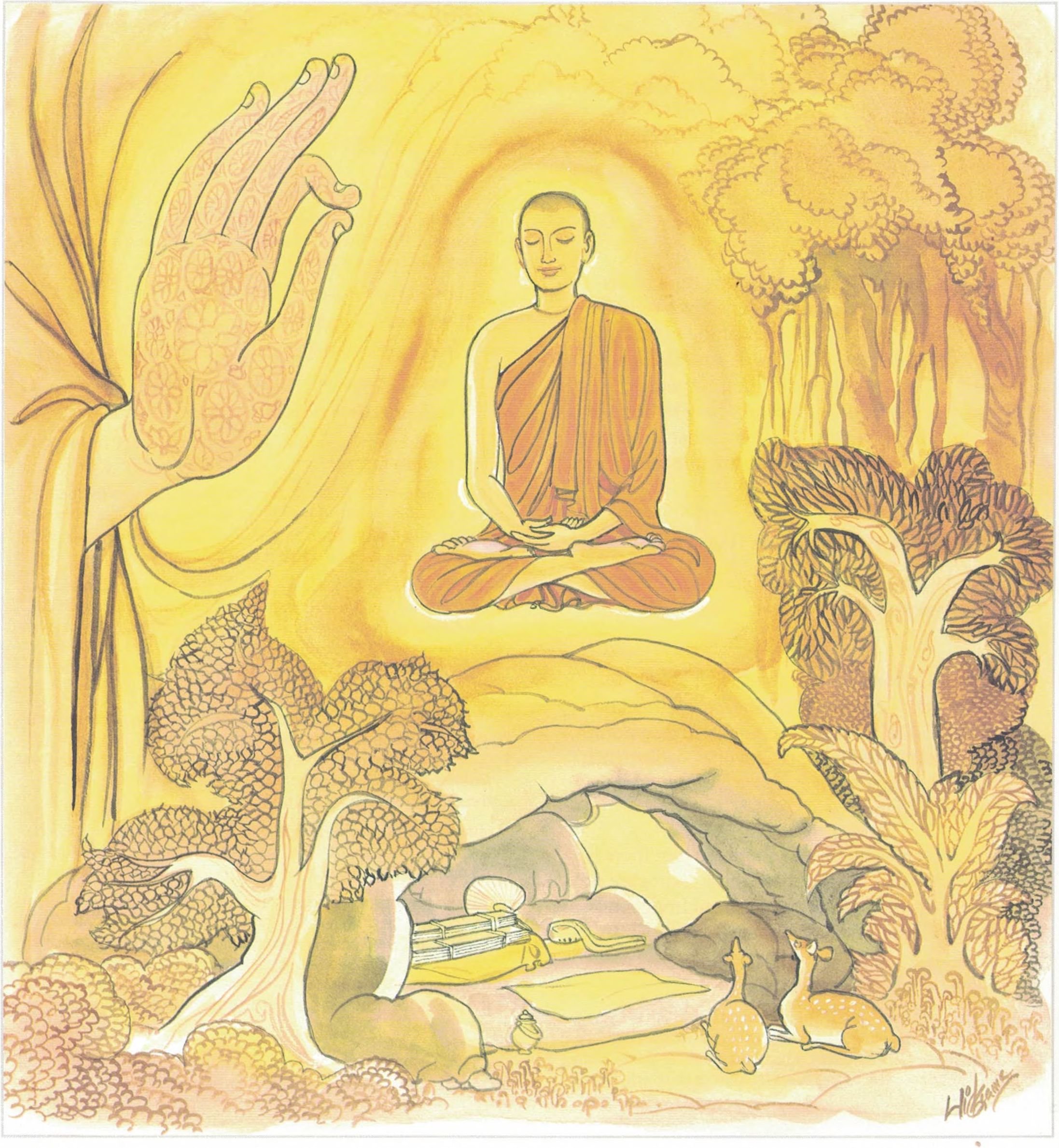Dhammapada (Illustrated)
by Ven. Weagoda Sarada Maha Thero | 1993 | 341,201 words | ISBN-10: 9810049382 | ISBN-13: 9789810049386
This page describes The Story of a Certain Brahmin which is verse 386 of the English translation of the Dhammapada which forms a part of the Sutta Pitaka of the Buddhist canon of literature. Presenting the fundamental basics of the Buddhist way of life, the Dhammapada is a collection of 423 stanzas. This verse 386 is part of the Brāhmaṇa Vagga (The Brāhmaṇa) and the moral of the story is “Sitting meditative, dust free, duties done and highest goal reached, him a true brahmin I call”.
Verse 386 - The Story of a Certain Brāhmin
Pali text, illustration and English translation of Dhammapada verse 386:
jhāyiṃ virajamāsīnaṃ katakiccaṃ anāsavaṃ |
uttamatthaṃ anuppattaṃ tamahaṃ brūmi brāhmaṇaṃ || 386 ||
386. Seated stainless, concentrated, who’s work is done, who’s free of taint, having attained the highest aim, that one I call a Brahmin True.
 Sitting meditative, dust free, duties done and highest goal reached, him a true brahmin I call. |
The Story of a Certain Brāhmin
While residing at the Jetavana Monastery, the Buddha spoke this verse with reference to a brāhmin.
The story goes that one day this brāhmin thought to himself, “The Buddha calls his own disciples ‘Brāhmans’, now I am by birth and lineage a brāhmin; therefore, he ought to apply this title to me also.” So, he approached the Buddha and asked him about the matter. The Buddha replied, “I do not call a man a brāhmin merely because of his birth and lineage; I call by this title only that man who has reached the supreme goal, arahatship.”
Explanatory Translation (Verse 386)
jhāyim virajam āsīnaṃ katakiccaṃ anāsavaṃ
uttamatthaṃ anuppattaṃ taṃ ahaṃ brāhmaṇaṃ brūmi
jhāyim: meditating; virajam: free of blemishes; āsīnaṃ [āsīna]: seated in solitude; katakiccaṃ [katakicca]: who has fulfilled his tasks; anāsavaṃ [anāsava]: free of taints; uttamatthaṃ [uttamattha]: the highest state (Nibbāna);anuppattaṃ [anuppatta]: reached; taṃ: that person; ahaṃ: I; brūmi brāhmaṇaṃ [brāhmaṇa]: describe as a brāhmaṇa
He is given to concentrated contemplation. He is free of all blemishes–the dust that defiles a being. He sits in solitude. All his spiritual tasks and obligations are done. He has reached the highest goal. That person I describe as a brāhmaṇa.
Commentary and exegetical material (Verse 386)
uttamatthaṃ anuppattaṃ: who has attained the highest spiritual states–arahantship: sainthood, noble one, noble person.
There are four noble individuals (ariya-puggala):
- The stream-winner (sotāpanna);
- the once-returner (sakadāgāmi);
- the non-returner (anāgāmi); and
- the holy one (arahat).
(1) Through the path of stream-winning (sotāpatti-magga) one becomes free from the first three fetters (samyojana) which bind beings to existence in the sensuous sphere, (i) sakkāyadiṭṭhi–personality-belief; (ii) vicīkiccā–skeptical doubt; (iii) sīlabbata-parāmāsa–attachment to mere rules and rituals.
(2) Through the path of once-returning (sakadāgāmi-magga) one becomes nearly free from the fourth and fifth fetters, (iv) kāmacchanda–sensuous craving; (v) vyāpāda–ill-will.
(3) Through the path of non-Returning (anāgāmi-magga) one becomes fully free from the abovementioned five lower fetters.
(4) Through the path of holiness (arahatta-magga) one further becomes free from the five higher fetters, (vi) rūparāga–craving for fine-material existence; (vii) arūpa-rāga–craving for immaterial existence; (viii) māna–conceit; (ix) uddacca–restlessness; (x) avijjā–ignorance.
(1) Sotāpañña–after the disappearance of the three fetters, the monk who has won the stream (to Nibbāna) and is no more subject to rebirth in lower worlds, is firmly established, destined for full enlightenment.
(2) sakadāgāmi–after the disappearance of the three fetters and reduction of greed, hatred and delusion, he will return only once more; and having once more returned to this world, he will put an end to suffering.
(3) anāgāmi–after the disappearance of the five fetters he appears in a higher world, and there he reaches Nibbāna without ever returning from the world (to the sensuous sphere).
(4) arahant–through the extinction of all cankers (āsavakkhaya) he reaches already in this very life the deliverance of mind, the deliverance through wisdom, which is free from cankers, and which he himself has understood and realized.
